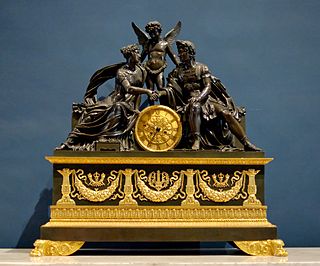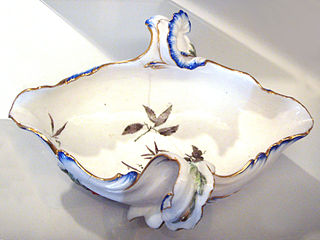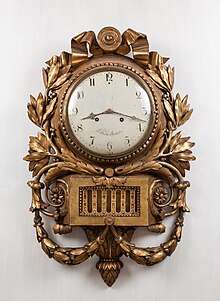
Rococo, less commonly roccoco, or "Late Baroque", is a highly ornamental and theatrical style of decoration which combines asymmetry, scrolling curves, gilding, white and pastel colors, sculpted molding, and trompe l'oeil frescoes to create the illusions of surprise, motion and drama. It first appeared in France and Italy in the 1730s and spread to Central Europe in the 1750s and 1760s. It is often described as the final expression of the Baroque movement.

Jean-François Oeben, or Johann Franz Oeben was a French ébéniste (cabinetmaker) whose career was spent in Paris. He was the maternal grandfather of the painter Eugène Delacroix.

Jean-Henri Riesener was the French royal ébéniste, working in Paris, whose work exemplified the early neoclassical "Louis XVI style".

American Empire is a French-inspired Neoclassical style of American furniture and decoration that takes its name and originates from the Empire style introduced during the First French Empire period under Napoleon's rule. It gained its greatest popularity in the U.S. after 1820 and is considered the second, more robust phase of the Neoclassical style, which earlier had been expressed in the Adam style in Britain and Louis Seize, or Louis XVI, in France. As an early-19th-century design movement in the United States, it encompassed architecture, furniture and other decorative arts, as well as the visual arts.

Ormolu is an English term, used since the 18th century for the gilding technique of applying finely ground, high-carat gold–mercury amalgam to an object of bronze, and for objects finished in this way.

Linderhof Palace is a Schloss in Germany, in southwest Bavaria near Ettal Abbey. It is the smallest of the three palaces built by King Ludwig II of Bavaria and the only one which he lived to see completed.

Charles Cressent (1685–1768) was a French furniture-maker, sculptor and fondeur-ciseleur of the régence style. As the second son of François Cressent, sculpteur du roi, and grandson of Charles Cressent, a furniture-maker of Amiens, who also became a sculptor, he inherited the tastes and aptitudes which were likely to make a finished designer and craftsman. Even more important perhaps was the fact that he was a pupil of André Charles Boulle. Trained in such surroundings, it is not surprising that he should have reached a degree of achievement which has to a great extent justified the claim that he was the best decorative artist of the 18th century. Cressent's distinction is closely connected with the regency, but his earlier work had affinities with the school of Boulle, while his later pieces were full of originality.

François-Honoré-Georges Jacob-Desmalter (1770–1841) oversaw one of the most successful and influential furniture workshops in Paris, from 1796 to 1825. The son of Georges Jacob, an outstanding chairmaker who worked in the Louis XVI style and Directoire styles of the earlier phase of Neoclassicism and executed many royal commissions, Jacob-Desmalter, in partnership with his older brother, assumed the family workshop in 1796. Freed from the Parisian guild restrictions of the Ancien Régime, the workshop was now able to produce veneered case-pieces (ébénisterie) in addition to turned and carved seat furniture (menuiserie). When his brother died, Jacob-Desmalter drew his father from retirement and began to develop one of the largest furniture workshops in Napoleonic Paris.
Jacques Caffieri (1678–1755) was a French sculptor, working for the most part in bronze.

Rocaille was a French style of exuberant decoration, with an abundance of curves, counter-curves, undulations and elements modeled on nature, that appeared in furniture and interior decoration during the early reign of Louis XV of France. It was a reaction against the heaviness and formality of the Style Louis XIV. It began in about 1710, reached its peak in the 1730s, and came to an end in the late 1750s, replaced by neoclassicism. It was the beginning of the French baroque movement in furniture and design, and also marked the beginning of the Rococo movement, which spread to Italy, Bavaria and Austria by the mid-18th century.

Louis-Simon Boizot (1743–1809) was a French sculptor whose models for biscuit figures for Sèvres porcelain are better-known than his large-scale sculptures.

Pierre-Philippe Thomire (1751–1843) a French sculptor, was the most prominent bronzier, or producer of ornamental patinated and gilt-bronze objects and furniture mounts of the First French Empire. His fashionable neoclassical and Empire style furnishing bronzes established the highest standard in refined finish in the craft that the French called that of the fondeur-ciseleur, "founder-finisher". In his pre-Revolutionary training, Thomire appeared first as a ciseleur, in the division of duties that went into the production, for example, of a set of gilt-bronze wall-lights delivered for Marie-Antoinette's card-room, her Salon des Jeux at Compiègne: under the general supervision of Hauré, the wax and wooden model was carved by Martin, cast by Forestier, and chased by Thomire, as Pierre Verlet was able to show over fifty years ago.

A French Empire-style mantel clock is a type of elaborately decorated mantel clock made in France during the Napoleonic Empire between 1804–1814/15, although the timekeepers manufactured throughout the Bourbon Restoration (1814/1815–1830) are also included within this art movement since they share subject, decorative elements, shapes and style.
Joseph Baumhauer was a prominent Parisian ébéniste, one of several of German extraction. Having worked for some years as a journeyman for the German-born ébéniste François Reizell, he was appointed ébéniste privilegié du Roi in 1767, enabling him to skirt certain requirements of the Paris guild under royal privilege as well as a stiff entrance fee. He used the stamp ♣JOSEPH♣, the name by which he was commonly known to his contemporaries, between fleurs-de-lis emblematic of his royal appointment. Such stamps, like the long-mysterious B.V.R.B., served to mask the identity of cabinetmakers to the clientele of marchands-merciers, such as Lazare Duvaux, who owed the "ébéniste Joseph" 1726 livres at the time of his death. Furniture stamped by Baumhauer that is mounted with Sèvres porcelain plaques must have been commissioned and sold by Simon-Philippe Poirier, who maintained a monopoly of the production, having originally devised the decor. some furniture stamped by Joseph is veneered with panels of Japanese lacquer, another sure indication of the intervention of a marchand-mercier, who, rather than the cabinetmaker himself, was in a position to purchase Japanese screens and cabinets, have them disassembled and, once the wooden support of the lacquer surfaces had been planed down, applied as costly veneer panels. Other marchands-merciers for whom Joseph is known to have worked include Thomas-Joachim Hébert and Charles Darnault.
Augustin Blondel de Gagny was a French connoisseur of the arts and a collector whose series of Paris auction sales, which took place soon after his death were high-water marks of the history of collecting in 18th-century France. Paintings and sculptures that passed through Blondel de Gagny's collection are dispersed in many of the world's great museums. The prints from his collection are less easily traced.

Jean-Claude Chambellan Duplessis, called Duplessis père to distinguish him from his son, Jean-Claude-Thomas Chambellan Duplessis, was a goldsmith, sculptor and ceramics modeller, bronze-founder and decorative designer working in the Rococo manner. He served as artistic director of the Vincennes porcelain manufactory and its successor at Sèvres from 1748 to his death in 1774 and as royal goldsmith from 1758 to 1774.

Jean-Pierre Latz was one of the handful of truly outstanding cabinetmakers (ébénistes) working in Paris in the mid-18th century. Like several of his peers in the French capital, he was of German origin. His furniture is in a fully developed rococo style, employing boldly sculptural gilt-bronze mounts complementing marquetry motifs of flowers and leafy sprays, in figured tropical veneers like tulipwood, amarante, purpleheart and rosewood, often featuring the distinctive end-grain cuts. He also produced lacquered pieces, most famously the slant-front desk in the collection of Stavros Niarchos, Paris.
Pierre Roussel was a successful but somewhat pedestrian cabinetmaker (ébéniste) of Paris. He was joined in his extensive business by his two sons, Pierre-Michel and Pierre le jeune.

The Passemant astronomical clock is an astronomical clock designed by Claude-Simeon Passemant in the eighteenth century. It is displayed in the Salon de la pendule in the petit appartement du roi on the first floor of Versailles, France. The clock set the official time in France for the first time in the kingdom's history.

Barometer Clock (Boulle) by André-Charles Boulle is a late seventeenth-century French clock created out of ebony, turtle shell, brass, gilt bronze, and enamel. The clock case is decorated on all sides and was intended as either a centerpiece or for display on a mantel in front of a mirror. The centerpiece of the clock is a relief of "Father Time Carrying Off Truth."























